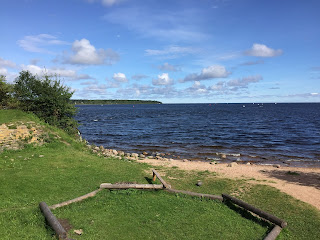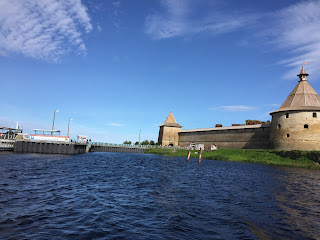121. Oreshek Fortress, Shlisselburg, & Lake Ladoga
Lake Ladoga is the largest lake in Europe - not quite twice as big as the runner up, and almost triple the size of the third largest body of water, a reservoir (both of these are also in Russia). The southwestern shore of the lake is roughly 50 kilometers (31 miles) east of St. Petersburg by car or bus. The Neva River originates in Lake Ladoga and flows right through central St. Petersburg on its way west to the Gulf of Finland. Shlisselburg is a small town on the south bank of the Neva that is situated at the mouth of the river.
Oreshek Fortress is a very short boat ride from Shlisselburg, occupying almost the entirety of an island located where Lake Ladoga flows into the Neva. The location is so conveniently placed for defensive purposes that a fort has been located there for almost 700 years. The first fort on this island was originally constructed by Grand Prince Yury of Moscow to guard against Swedish military incursions from the Baltic. Sweden ended up capturing the fort in 1611 during the Ingrian War (after a lengthy siege in which most of the defenders died of starvation), but it was retaken by Russia during the Great Northern War in 1702 and held ever since.
Oreshek has been of little strategic importance since the early eighteenth century (losing its position shortly after Kronstadt was built in 1704), with one exception. During the Great Patriotic War, the town of Shlisselburg was occupied by the Nazis for several years, but they were never able to take the fort, despite their repeated efforts. Russian troops successfully defended against frequent attacks for over 500 days, and they were instrumental in keeping open the "Road of Life" across the frozen Lake Ladoga, which allowed the wintertime transportation of food and supplies into the besieged city of Leningrad.
Today, the fortress walls surround a mix of restored buildings (mostly from the second Russian period, but a few areas from the Swedish period and the first Russian period) and ruined buildings. Some of the buildings that were destroyed by the frequent Nazi shelling during the Great Patriotic War have been left in that state as a memorial to the defending soldiers, although many of these structures are slated for future repair and restoration. Several sculptures are situated in the remains of the church walls in the middle of the fort as the main memorial to that period.
A prison is also located in one of the main buildings on the grounds of the fort. It was used for political prisoners in the late nineteenth and early twentieth centuries. It is reminiscent in purpose and appearance to the Trubetskoy Bastion Prison on the grounds of the Peter and Paul Fortress in St. Petersburg. In fact, some prisoners spent time at both places (Vladimir Lenin's brother Alexander Ulyanov, for example - before he was hanged at Oreshek). Eudoxia Lopukhina (Peter the Great's first wife) and the leaders of the Decembrist uprising of 1825 were other prominent "guests" at this grim building.
I enjoyed my visit to Oreshek. The military and political history of Russia and the Soviet empire is inextricably linked to this place, and I learned many fascinating details about important events in the founding and survival of St. Petersburg. The weather was beautiful when I was there, and this was an excellent site to feel the cool late summer breezes blowing in from Lake Ladoga. The fort is only open to visitors from May 1 to November 1 each year, so I don't expect to return in the next seven months.
Views of the Shlisselburg waterfront:
Oreshek Fortress is a very short boat ride from Shlisselburg, occupying almost the entirety of an island located where Lake Ladoga flows into the Neva. The location is so conveniently placed for defensive purposes that a fort has been located there for almost 700 years. The first fort on this island was originally constructed by Grand Prince Yury of Moscow to guard against Swedish military incursions from the Baltic. Sweden ended up capturing the fort in 1611 during the Ingrian War (after a lengthy siege in which most of the defenders died of starvation), but it was retaken by Russia during the Great Northern War in 1702 and held ever since.
Oreshek has been of little strategic importance since the early eighteenth century (losing its position shortly after Kronstadt was built in 1704), with one exception. During the Great Patriotic War, the town of Shlisselburg was occupied by the Nazis for several years, but they were never able to take the fort, despite their repeated efforts. Russian troops successfully defended against frequent attacks for over 500 days, and they were instrumental in keeping open the "Road of Life" across the frozen Lake Ladoga, which allowed the wintertime transportation of food and supplies into the besieged city of Leningrad.
Today, the fortress walls surround a mix of restored buildings (mostly from the second Russian period, but a few areas from the Swedish period and the first Russian period) and ruined buildings. Some of the buildings that were destroyed by the frequent Nazi shelling during the Great Patriotic War have been left in that state as a memorial to the defending soldiers, although many of these structures are slated for future repair and restoration. Several sculptures are situated in the remains of the church walls in the middle of the fort as the main memorial to that period.
A prison is also located in one of the main buildings on the grounds of the fort. It was used for political prisoners in the late nineteenth and early twentieth centuries. It is reminiscent in purpose and appearance to the Trubetskoy Bastion Prison on the grounds of the Peter and Paul Fortress in St. Petersburg. In fact, some prisoners spent time at both places (Vladimir Lenin's brother Alexander Ulyanov, for example - before he was hanged at Oreshek). Eudoxia Lopukhina (Peter the Great's first wife) and the leaders of the Decembrist uprising of 1825 were other prominent "guests" at this grim building.
I enjoyed my visit to Oreshek. The military and political history of Russia and the Soviet empire is inextricably linked to this place, and I learned many fascinating details about important events in the founding and survival of St. Petersburg. The weather was beautiful when I was there, and this was an excellent site to feel the cool late summer breezes blowing in from Lake Ladoga. The fort is only open to visitors from May 1 to November 1 each year, so I don't expect to return in the next seven months.
Views of the Shlisselburg waterfront:

























































































































Comments
Post a Comment